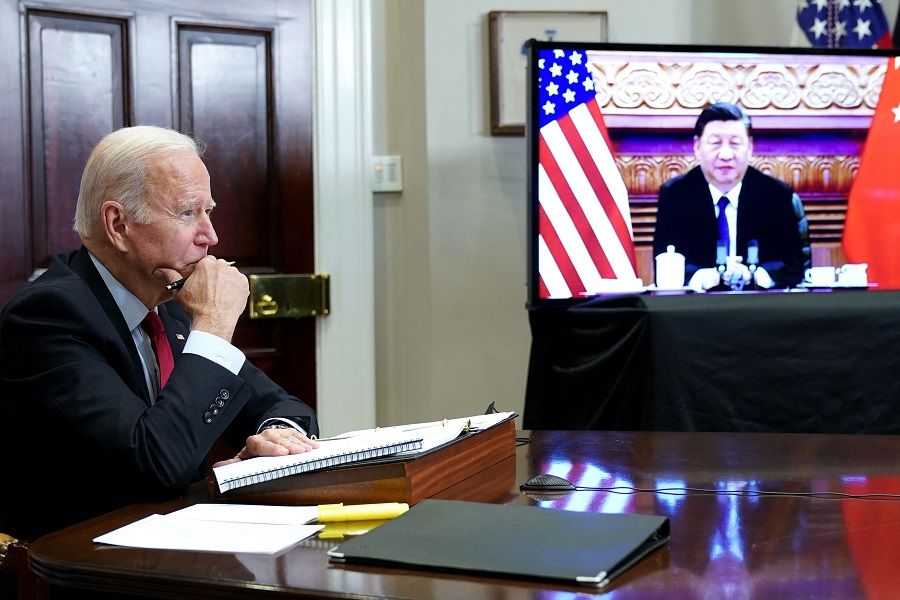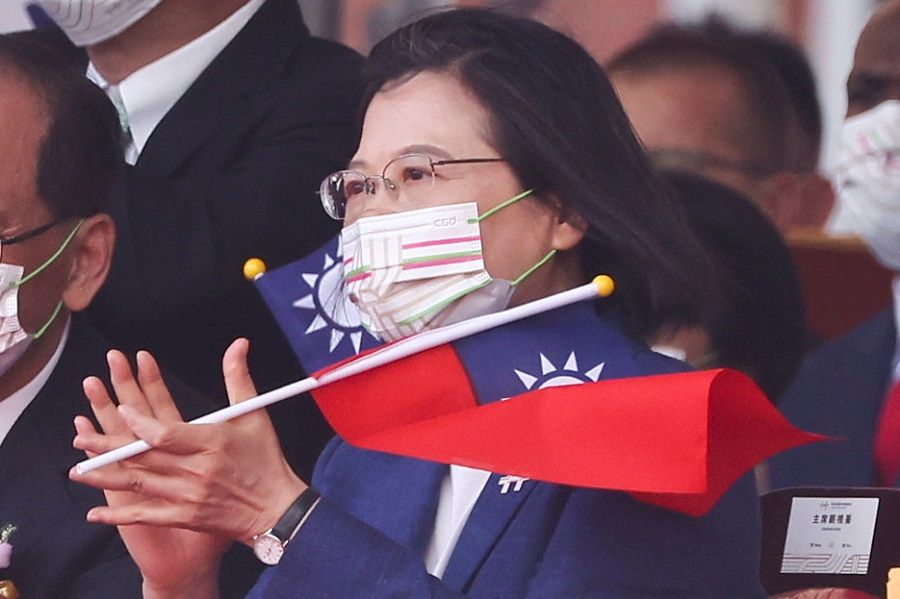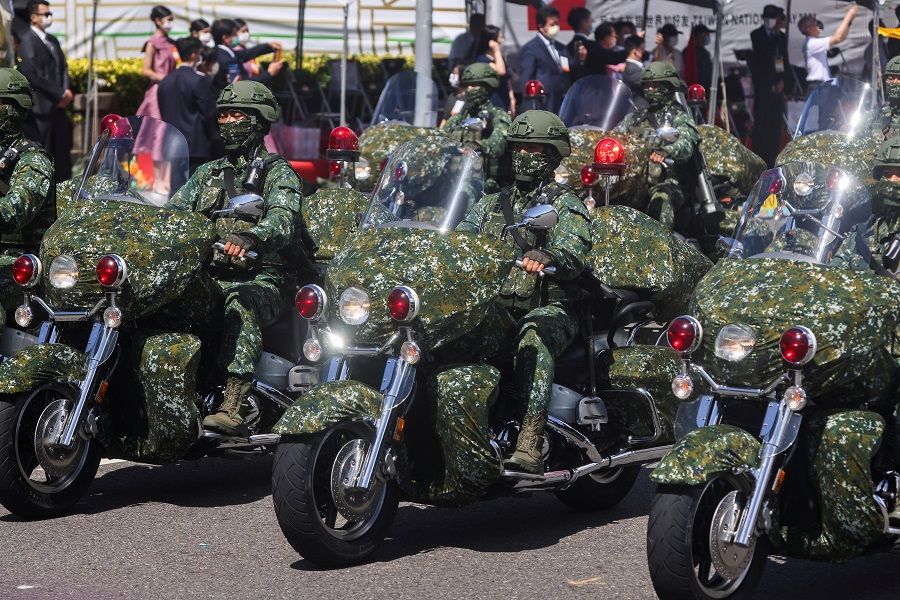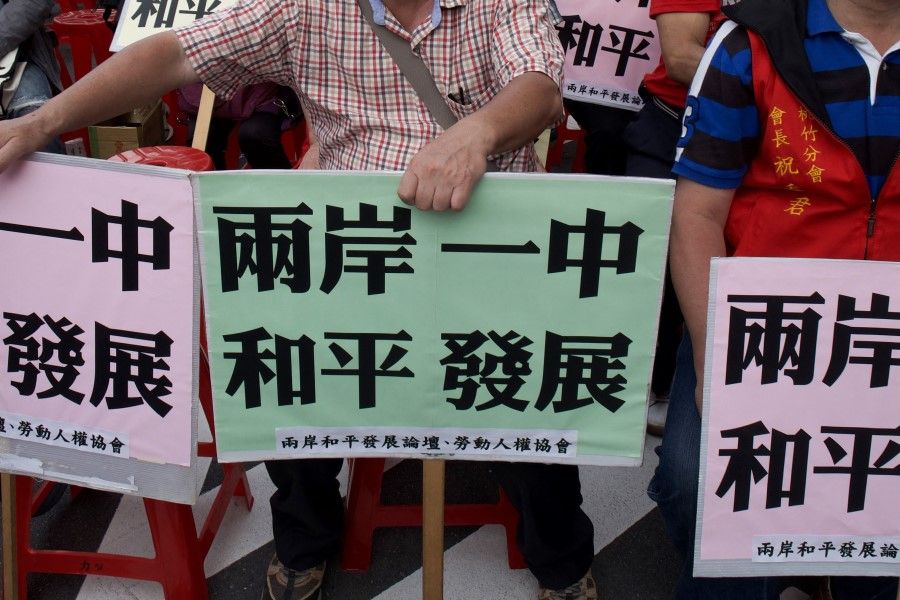Who dictates war and peace in the Taiwan Strait?

Over the past year, Taiwan, "the most dangerous place on earth", has been closely watched by international media. While the leaders of the mainland, the US, and Taiwan recently expressed sincerity in avoiding war, they are doing everything possible to prepare for war. The prospect of a cross-strait war is not that far-fetched.
Military, strategic, international relations, and foreign affairs experts we interviewed pointed out that each side of the Taiwan Strait holds the key to unlocking the Taiwan Strait issue. Crucially, can Taiwan's democracy be based on Chinese nationalism, and can the mainland's national rejuvenation dream take into account the existence of the Republic of China (ROC).
A need to settle the larger question of the Chinese nation
This is a significant question that concerns the Chinese nation. If the problem cannot be solved in the next few years, war in the Taiwan Strait would be hanging on a knife's edge. Conversely, if the leaders and people on both sides of the Taiwan Strait are able to use collective wisdom to find a way out, it is possible that there can be peace between the mainland and Taiwan.
In early October, mainland China's People's Liberation Army (PLA) sent 150 warplanes near Taiwan within five days, with a record 56 warplanes dispatched on 4 October alone. The mainland's incursion into Taiwan's air defence identification zone (ADIZ) can be seen as declaring sovereignty over Taiwan, and also sending a warning and strong political signal to the six countries - including the US, the UK, Japan, and the Netherlands - that conducted a joint military exercise southwest of Okinawa.

An ADIZ does not equate to sovereign airspace; its boundaries are much wider. It is an area that is easy for a military to locate and gain control of. According to international law, entering an ADIZ does not mean an invasion. Whenever mainland Chinese warplanes fly into Taiwan's ADIZ, the Taiwan military would dispatch air patrol aircrafts, issue radio warnings and deploy air defence missile systems to monitor the mainland's planes.
Based on information from Taiwan's Ministry of National Defense, between 16 September 2020 and 31 August 2021, the PLA deployed a total of 554 warplanes into Taiwan's ADIZ. In November this year, the PLA also flew warplanes near Taiwan almost daily, and only stopped doing so for a day on 3 November.
Amid the commotion in Taiwan's ADIZ, it was not all peace and quiet in the Taiwan Strait either. US warships sailed through the Taiwan Strait 11 times this year, while two PLA naval vessels simulated a landing attack against Taiwan in mid-November near Hualien. Naval forces from the five nations of Japan, the US, Australia, Canada, and Germany also dispatched 17 warships to the Philippine Sea to conduct military drills simulating an attack against the PLA from 21-30 November.
Leaders of the mainland, the US, and Taiwan sincerely want to avoid war
Amid the tense Taiwan Strait situation, top leaders of the mainland, the US, and Taiwan - all of whom are commanders-in-chief of their militaries - recently made clear political statements declaring their sincerity in avoiding war. At the same time, they have also drawn their red lines, erected their guardrails, and flashed their trump cards. While all three parties speak around the concept of "one China", they have different underlying intentions.
Mainland Chinese President Xi Jinping reiterated the commitment to striving for peaceful reunification on 9 October on the eve of the 110th anniversary of the Xinhai Revolution. During the Biden-Xi virtual summit on 15 November, Xi also said that Beijing has "patience and will strive for the prospect of peaceful reunification with utmost sincerity and efforts". But he also sternly warned that repeated attempts by the Taiwan authorities to seek US support for their independence agenda as well as the intention of some Americans to use Taiwan to contain China are just like "playing with fire" and that whoever plays with fire "will get burnt". If 'Taiwan independence' forces provoke Beijing, Beijing "will be compelled to take resolute measures".
While both countries mentioned "one China", Washington and Beijing actually have different definitions of the term.

In response, US President Joe Biden said that the US "remains committed to the 'one China' policy" and " strongly opposes unilateral efforts to change the status quo".
Washington and Beijing have different definitions of 'one China'
While both countries mentioned "one China", Washington and Beijing actually have different definitions of the term. The core of the mainland's "one China" principle is that the government of the People's Republic of China (PRC) is the sole legitimate government representing the whole of China, and that Taiwan is a part of China. But the US's "one China" policy stipulates that Taiwan's status is undetermined and promises to help Taiwan defend itself.
Regardless, the declarations of Xi and Biden dissipated the dark clouds looming over the Taiwan Strait, and are interpreted as China and the US erecting guardrails on the most sensitive issue of Taiwan amid China-US competition.
Democratic Progressive Party (DPP) yet to give up on 'Taiwan Independence Party Platform'
Taiwan President Tsai Ing-wen also expressed her sincerity in avoiding war during her Double Tenth Day address on 10 October. She said that Taiwan "will not act rashly", but emphasised that "there should be absolutely no illusions that the Taiwanese people will bow to pressure", reiterating her good intentions vis-à-vis cross-strait relations.

However, Tsai suddenly flashed her trump card on the "one China" issue that day, declaring that "the Republic of China and the People's Republic of China should not be subordinate to each other" and also emphasising that 72 years after both sides of the Taiwan Strait were divided in terms of governance, "the Republic of China (Taiwan)" has already been formed. Her remarks got people asking if Taiwan was moving towards the "two states" theory or the "one China, one Taiwan" concept.
In addition, constitutionally, it is called the ROC, and is not subordinate to the PRC. Any change to the status quo has to be decided by Taiwanese voters via a referendum.
In fact, following the 1949 split, the political stances of the PRC government governing the mainland and the ROC government governing Taiwan, Penghu, Kinmen and Matsu never deviated from the goal of reunification. Following the mainland's reform and opening up and rapid rise, it has always been strategically important to maintain peaceful development. The attitude of the government and the people towards the pursuit of cross-strait reunification remains unchanged as well.
Following three political party rotations in Taiwan, the ruling DPP has never given up on its "Taiwan Independence Party Platform" (台独党纲). But following the passing of the Resolution on Taiwan's Future in 1999, the party has been insisting that Taiwan is a de facto independent nation. In addition, constitutionally, it is called the ROC, and is not subordinate to the PRC. Any change to the status quo has to be decided by Taiwanese voters via a referendum.
That the ROC and PRC are not subordinate to each other was initially what the DPP said internally. But now that the president has publicly made this stance known, academics generally think that this represents mainstream public opinion. While it did not overstep the red line and declare de jure independence, it implies that Taiwan has made public its de facto independence.
Following the intense flexing of military muscles and political statements made by the top leaders of the mainland, the US, and Taiwan, the experts we interviewed agreed that the mainland is actively preparing for war to maintain the main agenda of peaceful reunification while not ruling out the possibility of military reunification at the same time. On the other hand, while the US promises to help Taiwan defend itself, it is also maintaining strategic ambiguity and does not make it clear if it would send troops to defend Taiwan. It did, however, sail warships through the Taiwan Strait and conduct joint military exercises with its allies to reveal what it could do should war occur.

The experts also pointed out that at the same time when the PLA is launching intensive military training with the goal of attacking Taiwan, and the US is supporting Taiwan by conducting military exercises with its allies, selling weapons to Taiwan, and training Taiwan troops, Taiwan's defence capabilities and the means taken to alleviate tensions are also key to avoiding war.
Su Tzu-yun, director of the Institute for National Defense and Security Research's Division of Defense Strategy and Resources, said, "Only with power can there be peace." Quoting from Sun Tzu's The Art of War, he said, "The art of war teaches us to rely not on the likelihood of the enemy's not coming, but on our own readiness to receive him." That is to say, war can only be prevented if the Taiwan military strengthens its defence capabilities and resolve.
Su added that the PLA has strengthened its naval and air power projection capabilities, and also developed sea power and nuclear strike capabilities, posing a great threat to Taiwan. "The Republic of China adopts a defensive posture and uses asymmetric combat power to offset the PLA's quantitative advantage in its volume of fighters and warships by investing in anti-air and anti-ship missiles," he said.
...it is just to protect the system, lifestyle and democratic freedom of the ROC, in the hope that its "friends in Beijing" will take a rational view of its existence. - Su Tzu-yun, director of the Institute for National Defense and Security Research's Division of Defense Strategy and Resources
Military for protection, not to oppose mainland China
Su also stressed that the military is only a tool for Taiwan to safeguard itself and not to make an enemy of the mainland; it is just to protect the system, lifestyle and democratic freedom of the ROC, in the hope that its "friends in Beijing" will take a rational view of its existence.
Alexander Huang Chieh-cheng, a former deputy minister on Taiwan's Mainland Affairs Council and currently an associate professor with the School of Strategic Studies at Tamkang University, said the Taiwan Strait issue has been regionalised and internationalised, but it is Beijing and Taiwan that hold the key to resolving cross-strait issues.

He said frankly that cross-strait trust is difficult right now, so all the more there is a need for mutual understanding and easing of tensions. He added, "Defence needs to be ramped up while mutual hostility and tension needs to be eased; all this is necessary. Taiwan needs to maintain friendly relations with the US and think about how to reduce Beijing's suspicions and aggression. The people of Taiwan can also choose during elections whether to protect Taiwan by continuing to raise the antagonism or easing the risk."
When it comes to the "key" to resolving the deadlock, Lin Hsien-Sen of the Department of East Asian Studies at the National Taiwan Normal University thinks Taiwan has to go back to the idea of Chinese nationalism or a Chinese nation, while mainland China also has to acknowledge the ROC.
He felt that the rhetoric of being "not subordinate to each other" and the reference to "Republic of China (Taiwan)" reflects the resolve of Taiwan's "23.5 million" nationalists and separatists to stand up to the nationalism of 1.4 billion mainland Chinese.
Lin previously studied in-depth the Chinese Communist Party (CCP)'s strategies during the Korean War. He cited the example of how the hit movie The Battle of Lake Changjin depicted the deployment of a million Chinese soldiers to help Korea against the US as a reminder not to underestimate the power of nationalism, adding that Taiwan should combine democracy with Chinese nationalism on both sides of the Taiwan Strait, for long-term peace and stability.
Veteran diplomat Jieh Wen-chieh, former Taiwan representative to New Zealand, feels that even as mainland China emphasises the great national rejuvenation dream and the pursuit of peaceful reunification, it also has to acknowledge the existence of the ROC and earnestly encourage a meeting of hearts across the Taiwan Strait.
"Is the CCP in touch with the ground in Taiwan? Apart from military measures and economic benefits for Taiwan, what 'soft' measures is it taking? Is it building true emotional connections and mutual trust? If there is no light touch, the only way is to end it by going hard." - Veteran diplomat Jieh Wen-chieh, former Taiwan representative to New Zealand

"Even Tsai Ing-wen has accepted the ROC, why can't mainland China? It is dangerous for mainland China to want to resolve at a stroke the different mindsets across the Taiwan Strait. To the Taiwanese, that is compulsion and plain conquest, which will only drive people on both sides of the Taiwan Strait further apart."
He feels that resolving the cross-strait issue is dependent on the Taiwanese, but also on whether the CCP is sincerely willing to "make friends in Taiwan" and work with Taiwan on an equal footing to build a future on both sides of the Taiwan Strait without setting any conditions, and to come up with a detailed action plan to encourage integration and reunification.
"Is the CCP in touch with the ground in Taiwan? Apart from military measures and economic benefits for Taiwan, what 'soft' measures is it taking? Is it building true emotional connections and mutual trust? If there is no light touch, the only way is to end it by going hard."
No fighting within next two years, but possibly in four to six years
Many observers assess that the situation in the Taiwan Strait could get "dangerous" between 2025 and 2027, when mainland China might initiate a lightning war and the US might join with Japan and Australia to launch a response.
When it comes to forecasts of when there might possibly be an offensive on Taiwan, Alexander Huang, who is also chairman of the Council on Strategic & Wargaming Studies (CSWS), says that putting together authoritative comments by the Taiwan and US military and national security heads, he estimates that "there will be no fighting in the next couple of years, but there is a risk in the next four to six years".

He thinks this is a more convincing prospect, considering a candidate from the pro-independence DPP might win Taiwan's presidential election in January 2024, while the US mid-term presidential election will also be held in November 2024, at which point mainland China will have new assessments to make.
He pointed out that 2024 marks the 45th anniversary of the Issuance of the Message to Compatriots in Taiwan, and with the approaching tenth anniversary of the reform of the PLA as well as crossing the halfway point of Xi's third term in office, it is possible that mainland China might consider making a move before 2025. In conjunction with the activation of personnel for military training at the beginning of each year, "it might shift to an offensive on Taiwan with just one phone call".
...the most probable scenario is for mainland China to launch a cyber attack to disrupt Taiwan's command and control systems, followed by a lightning war to seal the deal. - Ding Shuh-fan, Graduate Institute of East Asian Studies, National Chengchi University
In early October, Taiwan's Defence Minister Chiu Kuo-cheng also said the current situation with China is "the most serious" he has seen in his more than 40-year military career, and that China would have the ability to launch a "full-scale" invasion by 2025.
As to various recent popular analyses about offensives on Taiwan, mainland China military expert Ding Shuh-fan of the Graduate Institute of East Asian Studies at National Chengchi University felt the most probable scenario is for mainland China to launch a cyber attack to disrupt Taiwan's command and control systems, followed by a lightning war to seal the deal. He also noted that the US is gradually seeing Taiwan as a core interest, in order to maintain its global leadership position and economic interests in the Asia Pacific region, as well as the international status of the US dollar.
Su pointed out that if war broke out, one order from the US president and US troops could fly from its military base in Japan to Taiwan within 45 minutes, and allied troops would also assist.
Military gap between China and US has shrunk
Lin Hsien-Sen said US allies Japan and Australia would gather in the Taiwan Strait as the northern and southern vanguard. He added that Japan recently intended to increase its defence budget while Australia has been tapping on US and UK technology to build a nuclear-powered submarine fleet, which has added to mainland China's anxiety and sense of urgency in launching an offensive on Taiwan.
He felt that mainland China would consider taking Taiwan before 2027, before the figurative wings of Japan and Australia harden, and turn the stumbling block to its moving out of the west Pacific into a stepping stone.

These experts feel that the gap in military strength between China and the US has shrunk, and even as both sides are doing all they can to avoid war between the nuclear powers, the US is also stepping up on arming Taiwan and preparing for war by proxy.
Su said the gap between China and the US has shrunk to about ten years, while the PLA Navy is quickly playing catchup, with 355 vessels over the US's 305. However, the US Navy has a higher overall tonnage and a larger weapons capacity, while the PLA's 355 vessels have a displacement tonnage of just 2 million tons, far below the 4.6 million tons of the 305 US vessels.
Yang Yusheng, a retired navy colonel and writer for Asia-Pacific Defense magazine, felt that the military strength of China and the US are getting closer, and the US navy fleet and air force are wary of the PLA using long-distance rockets and drones to conduct area denial and counter-intervention strategies.
US is ramping up preparations to set up Taiwan as a war proxy to weaken and contain China's rise, which means that if there is fighting, Taiwan would be the biggest loser. - Veteran diplomat Jieh Wen-chieh, former Taiwan representative to New Zealand
Jieh Wen-chieh noted that in the past couple of years, US military sales to Taiwan have been unprecedented in volume and speed, and it is introducing a new bill to fund the Taiwanese military, hoping that Taiwan could put up a sustained fight and make mainland China see that attacking Taiwan would come with a high price.
He said the US is ramping up preparations to set up Taiwan as a war proxy to weaken and contain China's rise, which means that if there is fighting, Taiwan would be the biggest loser.
Chang Ching, a research fellow with the Society for Strategic Studies (中华战略学会), said that many people liken Taiwan's strategic position to a "hedgehog, porcupine, nut, scorpion, or venomous frog", but that is just expectations and not the reality. After all, there are too many scenarios and variables in war, and nobody can accurately forecast the situation. He gave a reminder that both sides of the Taiwan Strait are taking note that the US is treating Taiwan like Pearl Harbor in World War II to justify initiating an Eight-Nation Alliance-style move to surround and contain mainland China's rising strength, and also to shift focus away from the US's domestic economic and social issues.
Related: Has the US shifted its position on Taiwan, again? | Both sides of the Taiwan Strait fear imminent war | Why the status quo in the Taiwan Strait is quietly changing | Will the US abandon Taiwan? | The median line of the Taiwan Strait: No longer a boundary for mainland China | Peaceful or armed reunification: Are top Chinese advisers divided over Taiwan?
